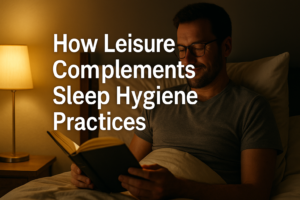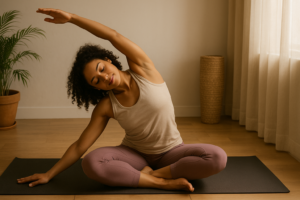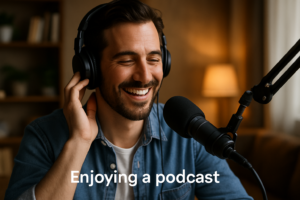Integrating Leisure with Other Health Practices
When I first started taking my leisure time seriously, I treated it as this separate category—something completely disconnected from the rest of my health routines. What a missed opportunity that was! It took me years to realize that leisure isn’t just an isolated wellness practice but rather a powerful connector that can enhance and amplify all other aspects of health.
Let me share how I’ve learned to integrate leisure with other wellness practices to create a more holistic and sustainable approach to well-being.
 When I swapped my nightly Instagram habit for a paperback novel, my sleep tracker showed I was falling asleep about 20 minutes faster.
The key is choosing leisure activities with the right qualities for that pre-sleep period. Activities that are:
When I swapped my nightly Instagram habit for a paperback novel, my sleep tracker showed I was falling asleep about 20 minutes faster.
The key is choosing leisure activities with the right qualities for that pre-sleep period. Activities that are:

 making meals a social leisure experience rather than a rushed necessity—
tend to eat more slowly, consume less overall, and make more nutritious choices.
My monthly dinner club has become as much about nourishing connections as it is about the food itself.
Even garden-tending as leisure has improved my nutrition.
Growing even a few herbs or vegetables connects you to your food source and typically increases vegetable consumption.
My modest balcony garden produces only a fraction of what I eat, but it’s changed how I think about all my food choices.
making meals a social leisure experience rather than a rushed necessity—
tend to eat more slowly, consume less overall, and make more nutritious choices.
My monthly dinner club has become as much about nourishing connections as it is about the food itself.
Even garden-tending as leisure has improved my nutrition.
Growing even a few herbs or vegetables connects you to your food source and typically increases vegetable consumption.
My modest balcony garden produces only a fraction of what I eat, but it’s changed how I think about all my food choices.

 I’ve created what I call “stress-specific leisure prescriptions” for different scenarios:
I’ve created what I call “stress-specific leisure prescriptions” for different scenarios:
 The reverse application works too—bringing awareness of exercise benefits to leisure activities encourages me to choose more active forms of leisure.
Knowing that dancing at my friend’s wedding burned calories was never my primary motivation,
but recognizing the dual benefits helped me stay on the dance floor longer.
For those struggling to maintain consistent exercise, starting with “leisure-first” physical activities can be a more sustainable approach than traditional workout programs.
The activities you’re naturally drawn to for enjoyment are the ones you’re most likely to continue long-term.
The reverse application works too—bringing awareness of exercise benefits to leisure activities encourages me to choose more active forms of leisure.
Knowing that dancing at my friend’s wedding burned calories was never my primary motivation,
but recognizing the dual benefits helped me stay on the dance floor longer.
For those struggling to maintain consistent exercise, starting with “leisure-first” physical activities can be a more sustainable approach than traditional workout programs.
The activities you’re naturally drawn to for enjoyment are the ones you’re most likely to continue long-term.

 a momentary pause for stress reduction, and a small dose of pleasure—all in five minutes or less.
The beauty of these integrated practices is their efficiency and sustainability.
When leisure is woven throughout your health routines rather than competing with them for time and attention, the whole system becomes more resilient and enjoyable.
The ultimate goal isn’t perfect adherence to separate health practices but rather creating a life where leisure and health routines flow together so naturally that they sustain and reinforce each other.
It’s taken me years of experimentation to find these integrations, but the resulting well-being has been well worth the journey.
a momentary pause for stress reduction, and a small dose of pleasure—all in five minutes or less.
The beauty of these integrated practices is their efficiency and sustainability.
When leisure is woven throughout your health routines rather than competing with them for time and attention, the whole system becomes more resilient and enjoyable.
The ultimate goal isn’t perfect adherence to separate health practices but rather creating a life where leisure and health routines flow together so naturally that they sustain and reinforce each other.
It’s taken me years of experimentation to find these integrations, but the resulting well-being has been well worth the journey.
How Leisure Complements Sleep Hygiene Practices
My struggle with insomnia was what actually led me to discover the powerful connection between leisure and sleep. After trying all the standard sleep hygiene advice— After trying all the standard sleep hygiene tips, I still struggled—until I realized the missing piece was leisure. I go into more detail on how sleep and recovery go hand-in-hand in this post on sleep and muscle recovery. I was still tossing and turning for hours. The missing piece? A proper wind-down routine that included genuine leisure. I discovered that specific types of evening leisure activities act as powerful sleep primers. Reading fiction for 30 minutes before bed has been shown to reduce sleep onset time by an average of 15 minutes compared to scrolling on phones. When I swapped my nightly Instagram habit for a paperback novel, my sleep tracker showed I was falling asleep about 20 minutes faster.
The key is choosing leisure activities with the right qualities for that pre-sleep period. Activities that are:
When I swapped my nightly Instagram habit for a paperback novel, my sleep tracker showed I was falling asleep about 20 minutes faster.
The key is choosing leisure activities with the right qualities for that pre-sleep period. Activities that are:
- Low physical intensity but mentally engaging
- Screen-free (to avoid blue light exposure)
- Pleasurable but not overly stimulating
- Consistent enough to become a sleep cue

Connecting Leisure Activities with Nutritional Well-being
The connection between leisure and nutrition was less obvious to me until I noticed how much my food choices improved when I addressed the emotional needs that leisure fulfills. Many of us eat not just for hunger but for stimulation, comfort, or as a default activity when bored. When my leisure needs weren’t being met, I often turned to food to fill that void— mindlessly snacking while watching TV or stress-eating after work instead of engaging in genuinely rejuvenating activities. Once I established regular leisure practices that truly nourished my need for pleasure, creativity, and relaxation, my emotional eating decreased significantly. Having options besides food to meet those emotional needs created more space for intuitive eating. I’ve also found that certain leisure activities naturally pair with healthier eating patterns. Transforming cooking from a chore into a leisure activity helped me become more mindful about what I eat. For more practical ideas on age-appropriate nutrition, check out my post on healthy eating tips for men over 45. When I approach cooking as a creative, mindful practice rather than just meal prep, I’m more invested in nutritious ingredients and more present during meals. Social leisure also influences nutrition in fascinating ways. Research shows that people who regularly engage in communal eating— making meals a social leisure experience rather than a rushed necessity—
tend to eat more slowly, consume less overall, and make more nutritious choices.
My monthly dinner club has become as much about nourishing connections as it is about the food itself.
Even garden-tending as leisure has improved my nutrition.
Growing even a few herbs or vegetables connects you to your food source and typically increases vegetable consumption.
My modest balcony garden produces only a fraction of what I eat, but it’s changed how I think about all my food choices.
making meals a social leisure experience rather than a rushed necessity—
tend to eat more slowly, consume less overall, and make more nutritious choices.
My monthly dinner club has become as much about nourishing connections as it is about the food itself.
Even garden-tending as leisure has improved my nutrition.
Growing even a few herbs or vegetables connects you to your food source and typically increases vegetable consumption.
My modest balcony garden produces only a fraction of what I eat, but it’s changed how I think about all my food choices.

Using Leisure as a Component of Stress Management
Perhaps the most powerful integration I’ve experienced is between leisure and stress management. After burning out at work several years ago, I learned that leisure isn’t just a nice-to-have but an essential component of any effective stress management strategy. The key insight was discovering that different types of stress require different leisure responses. For acute, situation-specific stress (like after a difficult meeting), active leisure activities that involve physical movement help metabolize stress hormones. A quick walk, dance break, or brief stretching session can reset your nervous system in as little as 10 minutes. For chronic, ongoing stress (like caring for an ill family member), restorative leisure practices become essential. Activities that activate your parasympathetic nervous system— like nature exposure, certain types of creative expression, or meaningful social connection—can counterbalance the effects of long-term stress. I’ve created what I call “stress-specific leisure prescriptions” for different scenarios:
I’ve created what I call “stress-specific leisure prescriptions” for different scenarios:
- For mental fatigue: Nature-based or physical leisure
- For emotional depletion: Creative or social leisure
- For decision fatigue: Structured leisure with clear rules (like games)
- For physical tension: Movement-based leisure with mind-body connection
The Relationship Between Leisure and Exercise Routines
I used to keep my “exercise” and “leisure” categories completely separate—one was for health, the other for fun. This artificial separation made exercise feel like a chore and kept me from recognizing the physical benefits of my leisure activities. The game-changer was finding overlap between the two. Some activities, like hiking or recreational tennis, offer both the benefits of exercise and the enjoyment of leisure. If you’re looking for age-appropriate workouts that combine effectiveness with enjoyment, don’t miss my post on the best exercises for men over 45. For me, hiking and recreational tennis fit this sweet spot—they provide significant physical benefits while also delivering the psychological renewal that defines true leisure. Even for exercise that doesn’t feel like leisure (I’m looking at you, burpees), leisure integration can transform the experience. Combining my strength training with audiobooks or podcasts I genuinely look forward to has created a positive association that makes me actually eager for workout time. The reverse application works too—bringing awareness of exercise benefits to leisure activities encourages me to choose more active forms of leisure.
Knowing that dancing at my friend’s wedding burned calories was never my primary motivation,
but recognizing the dual benefits helped me stay on the dance floor longer.
For those struggling to maintain consistent exercise, starting with “leisure-first” physical activities can be a more sustainable approach than traditional workout programs.
The activities you’re naturally drawn to for enjoyment are the ones you’re most likely to continue long-term.
The reverse application works too—bringing awareness of exercise benefits to leisure activities encourages me to choose more active forms of leisure.
Knowing that dancing at my friend’s wedding burned calories was never my primary motivation,
but recognizing the dual benefits helped me stay on the dance floor longer.
For those struggling to maintain consistent exercise, starting with “leisure-first” physical activities can be a more sustainable approach than traditional workout programs.
The activities you’re naturally drawn to for enjoyment are the ones you’re most likely to continue long-term.
How Leisure Can Support Medication/Therapy for Mental Health Conditions
As someone who has managed depression for years, I’ve experienced firsthand how proper leisure integration can amplify the effectiveness of both therapy and medication. While leisure shouldn’t replace professional mental health treatment, it can significantly enhance outcomes when used as a complementary practice. Certain leisure activities directly reinforce therapeutic techniques. My therapist’s cognitive behavioral exercises became much more effective when I integrated them with nature walks. Something about the combination of physical movement, natural settings, and mindful thought work accelerated my progress in challenging negative thought patterns. For those on medication for mental health conditions, appropriate leisure can help manage side effects and enhance overall quality of life. When a friend experienced decreased motivation as a side effect of her anxiety medication, building small, achievable leisure activities into her daily routine provided dopamine boosts that counterbalanced this effect. Leisure can also provide valuable data points for therapy. Tracking my leisure patterns—what I enjoyed, avoided, or felt unable to engage with— gave my therapist insights into my mental state that I couldn’t always articulate directly. Periods when I avoided previously enjoyable activities became recognized as early warning signs of depressive episodes. The social connection aspect of leisure deserves special mention for mental health support. Group-based leisure activities combat isolation, which is both a contributor to and consequence of many mental health conditions. My monthly book club has been as therapeutic as many of my formal therapy sessions.
Creating Rituals That Combine Multiple Well-being Practices
The most powerful approach I’ve found is creating integrated wellness rituals that combine leisure with other health practices. These multi-benefit routines deliver more than the sum of their parts and are more likely to become sustainable habits. My Sunday morning “renewal ritual” combines several health practices into one seamless experience:- A leisurely 30-minute nature walk (physical activity + nature exposure)
- Followed by farmers market shopping (social connection + nutrition)
- Then preparing a special breakfast while listening to a favorite podcast (nutrition + intellectual leisure)
- Enjoying the meal without screens while planning my week (mindful eating + organization)
 a momentary pause for stress reduction, and a small dose of pleasure—all in five minutes or less.
The beauty of these integrated practices is their efficiency and sustainability.
When leisure is woven throughout your health routines rather than competing with them for time and attention, the whole system becomes more resilient and enjoyable.
The ultimate goal isn’t perfect adherence to separate health practices but rather creating a life where leisure and health routines flow together so naturally that they sustain and reinforce each other.
It’s taken me years of experimentation to find these integrations, but the resulting well-being has been well worth the journey.
a momentary pause for stress reduction, and a small dose of pleasure—all in five minutes or less.
The beauty of these integrated practices is their efficiency and sustainability.
When leisure is woven throughout your health routines rather than competing with them for time and attention, the whole system becomes more resilient and enjoyable.
The ultimate goal isn’t perfect adherence to separate health practices but rather creating a life where leisure and health routines flow together so naturally that they sustain and reinforce each other.
It’s taken me years of experimentation to find these integrations, but the resulting well-being has been well worth the journey. 